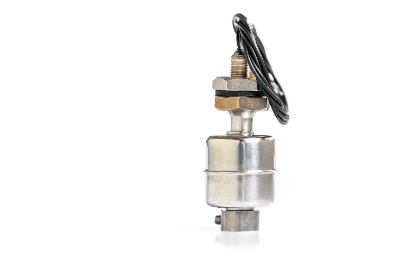What Is a Level Switch?
 A level switch is a type of sensor used to detect the remaining amount of a substance, such as liquid or powder.
A level switch is a type of sensor used to detect the remaining amount of a substance, such as liquid or powder.
It is indispensable for inventory control and maintenance operation of product tanks. There are many types, from simple to highly precise.
Uses of Level Switches
Level switches are primarily used in material storage facilities. These include tanks for storing liquids such as tap water and chemicals, and service hoppers for dropping powder materials.
Tanks also come in a variety of shapes, sizes, and installation methods, so the appropriate level switches are used depending on the orientation and situation in which it is installed. The purpose of installation can be classified into cases where the switch is installed simply to detect and report the remaining amount in the tank, and cases where the switch provides some kind of feedback control to other equipment when a certain threshold value is crossed.
Principle of Level Switches
Level switches can be broadly classified into two types: the “float type” that detects liquids, and the “sound type” that detects powders and other substances.
1. Float Type
Float-type level switches, which are often used to detect liquids, are level switches with a float attached and are mechanically controlled. When the float is not in contact with the liquid, the float is tilted and the internal circuit on the opposite side of the float is disconnected. On the other hand, when the float is pushed up by the liquid, the circuit on the opposite side makes contact and conducts the circuit, thus detecting a transition. However, the float type can only detect liquid.
2. Sonic Type
Sound level switches are used to detect powders. A sound level that constantly vibrates at a certain frequency is prepared, and when a powder or other object comes into contact with the level switches, a different frequency from that in the air is detected. The change in frequency is used to determine the position of the powder.
How to select Level Switches
The level switches to be selected depend on whether the substance to be detected is a liquid or a solid, such as powder. For simple applications, such as detecting the remaining amount of liquid, a float switch would be suitable. For chemicals, it is important to check for chemical resistance.
For solids, sound level switches are suitable, but depending on the particle size or size, there may be problems such as getting caught at the sound level. There are also level switches that use other principles, such as electrode-type switches, so it is a good idea to consult with the manufacturer.
Other Information on Level Switches
1. Electrode Type Level Switches
Electrode-type level switches consist of an amplifier, which is a power supply unit that applies a very low voltage between the electrodes, and a pole-holding device. The amplifier contacts often have hysteresis, shorting the contacts from the time the high electrode touches the surface of the liquid until the low electrode breaks the level.
The holding fixture is made of resin or other insulating material to insulate the electrodes from the surrounding fittings. The electrodes generally consist of three electrodes: a common electrode, a high-level electrode, and a low-level electrode. Two electrodes may be used for alarm purposes.
Float-type level switches cannot be used in tanks with agitators, whereas electrode-type switches can be used stably. However, they cannot be used with nonconductive liquids (e.g., oil).
Also, depending on the type of liquid, the electrode may dissolve due to corrosion, etc. Therefore, the electrode material must be carefully selected. In general, SUS304 or SUS316L is often used for the detection of less corrosive liquids. For highly corrosive liquids, Hastelloy or titanium are used, but they are more expensive.
2. Capacitive Level Switches
Capacitive level switches are level switches that can be used with powders and liquids. In principle, a grounded electrode and an electrode for detection are insulated and arranged, and the switch operates by detecting changes in capacitance between the electrodes when they come in contact with liquid. Since detection is based on capacitance, the level detection of insulating materials is also possible.
The shape is a single cylinder, which is attached to the side of a chemical tank or hopper. The disadvantage is that since it detects by contacting the object to be measured, there is a risk of false detection due to corrosion or sticking.